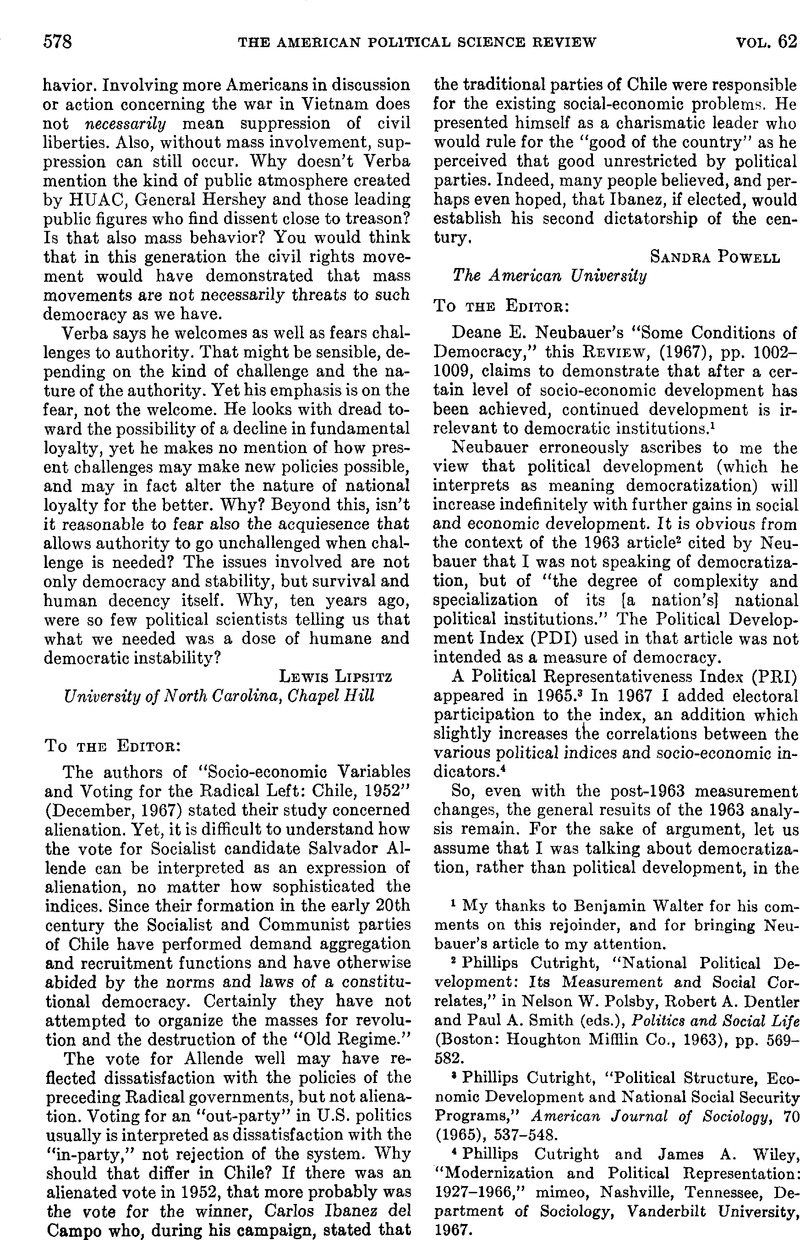Article contents
[no title]
Published online by Cambridge University Press: 01 August 2014
Abstract

- Type
- Communications to the Editor
- Information
- Copyright
- Copyright © American Political Science Association 1968
References
page 578 note 1 My thanks to Benjamin Walter for his comments on this rejoinder, and for bringing Neubauer's article to my attention.
page 578 note 2 Cutright, Phillips, “National Political Development: Its Measurement and Social Correlates,” in Polsby, Nelson W., Dentler, Robert A. and Smith, Paul A. (eds.), Politics and Social Life (Boston: Houghton Mifflin Co., 1963), pp. 569–582.Google Scholar
page 578 note 3 Cutright, Phillips, “Political Structure, Economic Development and National Social Security Programs,” American Journal of Sociology, 70 (1965), 537–548.CrossRefGoogle Scholar
page 578 note 4 Cutright, Phillips and Wiley, James A., “Modernization and Political Representation: 1927–1966,” mimeo, Nashville, Tennessee, Department of Sociology, Vanderbilt University, 1967.Google Scholar
page 580 note 5 See Outright, Phillips, “Income Redistribution: A Cross National Analysis,” Social Forces, 46 (1967), 180–190 CrossRefGoogle Scholar for data and analysis. The number of cases used in this and the following correlations vary according to the availability of data, unless other reasons for omitting cases are given.
page 580 note 6 See Outright, Phillips, “Inequality: A Cross National Analysis,” American Sociological Review, 32 (1967), 562–578 CrossRefGoogle Scholar for data and analysis.
page 580 note 7 See Outright, Phillips, “Occupational Inheritance: A Cross National Analysis,” American Journal of Sociology, 73 (1968)Google Scholar, for data and analysis.
page 580 note 8 Data from Russett, Bruce M., et al., World Handbook of Political and Social Indicators, New Haven: Yale University Press, 1964, pp. 218–219.Google Scholar Nations below $400 per capita GNP (data from Russett, et al., op. cit. pp. 155–156) are omitted to put a rough control on economic development; Switzerland and Norway are also dropped since only public school enrollments in these nations were available to Russett.
page 580 note 9 Data from Lowenstein, Ralph L., “World Press Freedom, 1966”, Columbia, Missouri: School of Journalism, University of Missouri at Columbia, 05, 1967, Table III.Google Scholar In this report nations are grouped into eight levels on a measure of “Press Freedom.” Removal of the four nations in Neubauer's list with less than $400 per capita GNP (plus Luxemburg, for which no Press Freedom rating was listed) leaves 18 cases. Ten of the 18 nations are in the upper level and the remaining eight are in the second level on Press Freedom. Within the upper level a rank order is available for the top six nations. (See “A Charter Subscription Offering for Interplay: A Review of European /American Affairs,” New York: Interplay, 200 West 57th Street (January, 1968), p. 1. A common rank was assigned to the remaining four nations in the upper level and a common rank assigned to the eight nations in the second level. For example, Great Britain and France were ranked first and second on Democratic Performance by Neubauer, but were both in the second level (assigned a rank of 14.5) on Press Freedom; Switzerland is ranked in 18th position on Democratic Performance, but is second on Press Freedom.
- 1
- Cited by




